

| This area shows skydiving and some other extreme sports (including hang-gliding and snow mobiling)! I have been skydiving since May of 1992 and it is my favorite extreme sport to this date! There is also some "other extreme" sports areas on this page, such as surfing. Such skydiving events as the World Freefall Convention and many "specialty" skydives are also on this page. See a skydive from 24,000 feet over Lake Okeechobee / Pahokee, FL! See what its like to skydive out of an upside-down (inverted) bi-plane (Pitts Special)! See footage of a skydive out of a DC-9 commericial jet transport hurtling along at over 220 MPH! If you love skydiving, this is the page to visit! Note - This page may take a while to load on some SLOWER connections, but even with the cheapest website hosting, you will be able to enjoy these fun, fantastic images! |
Chris Collura - Skydiver - USPA License C30317
Looking HERE for my section on ROLLER COASTERS AND EXTREME RIDES? Well, that section has been MOVED to it's own area! You can click the link provided BELOW or click HERE to jump right to my section on ROLLER COASTERS AND EXTREME RIDES!
 ROLLER COASTERS AND EXTREME RIDES
ROLLER COASTERS AND EXTREME RIDES
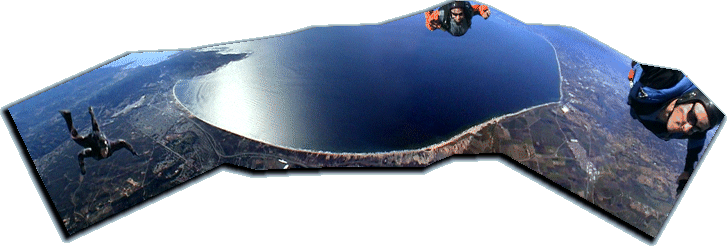
The picture above is a composite panorama taken from a helmet-mounted camera high above Skydive Monterey bay in Marina, California, and is a great photo for brochures printing, a postcard, and custom business cards. The background in the image is the awesome panorama, stretching from south to the north, with the Monterey Bay and Peninsula to the far left, view of the Pacific Ocean to the west, and Santa Cruz and "Bay Area" valley to the far right. The background for the image showing the view is a composite of six images captured from helmet-camera video on a skydive from 19,000 feet. Overlaid on the images, are a few other jumpers, taken from an attempted 10-way building from 18,000 feet on a second jump, and composted onto the background panorama to provide the viewer a point-of-view (POV) and wide-angle perspective of the skydiving experience. Skydive Monterey Bay is a fantastic drop-zone located near Monterey Bay and is about an hour and a half from San Francisco. They consistently do 18,000 foot (or more) skydives, some of the "highest" in the World for such a regular-basis!
 VR Video Of Hot Air Balloon Skydive Over Perris CA In November 2024 (New!)
VR Video Of Hot Air Balloon Skydive Over Perris CA In November 2024 (New!) 360 VR Video Of Perris CA DC-9 Jet Jump In October 2024 (New!)
360 VR Video Of Perris CA DC-9 Jet Jump In October 2024 (New!) Skydiving From DC-9 Jet Airliner At Perris CA In October 2024 (New!)
Skydiving From DC-9 Jet Airliner At Perris CA In October 2024 (New!) "Cloud Hopping" Skydiving Music Video Mixdown 2024
"Cloud Hopping" Skydiving Music Video Mixdown 2024 Skydive High-Pull Fun Above The Clouds In June 2024 (VR 360 Video)
Skydive High-Pull Fun Above The Clouds In June 2024 (VR 360 Video) High Pull Skydive Over Clewiston FL On May 4, 2024
High Pull Skydive Over Clewiston FL On May 4, 2024 360 VR Skydive From 18,000 Feet Over Texas (4k)
360 VR Skydive From 18,000 Feet Over Texas (4k) High-Pull Skydive With Data Plots - March 16, 2024 (4k)
High-Pull Skydive With Data Plots - March 16, 2024 (4k) USPA Skydiving Nationals (Illinois) - Sept 13, 2014
USPA Skydiving Nationals (Illinois) - Sept 13, 2014 Skydive High-Pull And Towering Cumulus (9/9/2023)
Skydive High-Pull And Towering Cumulus (9/9/2023) Cloud-Carving Skydive (4/8/2023) 360 VR Music Video (4k)
Cloud-Carving Skydive (4/8/2023) 360 VR Music Video (4k) 25-Years Skydiving Techno-Music Extended Montage (2+ Hours)
25-Years Skydiving Techno-Music Extended Montage (2+ Hours) Towering Cumulus Skydiving Music Video Mixdown 2022
Towering Cumulus Skydiving Music Video Mixdown 2022 Skydiving Music Video Mixdown 2022
Skydiving Music Video Mixdown 2022 Extreme Activities Mix 360 VR Music Video (4k)
Extreme Activities Mix 360 VR Music Video (4k) Skydiving Music Video Mixdown 2021
Skydiving Music Video Mixdown 2021 Perris Sikorsky 58T Helicopter Jump In August 2021
Perris Sikorsky 58T Helicopter Jump In August 2021 Lake Elsinore A350 Helicopter Jump In July 2021
Lake Elsinore A350 Helicopter Jump In July 2021 Lake Elsinore A350 Helicopter Jump In Jan 2021 With Music
Lake Elsinore A350 Helicopter Jump In Jan 2021 With Music Skydiving Music Video Mixdown 2020
Skydiving Music Video Mixdown 2020 Helicopter Jumps At CSC Independence Boogie And My First Malfunction In July 2019
Helicopter Jumps At CSC Independence Boogie And My First Malfunction In July 2019 Everglades Boogie In 2018
Everglades Boogie In 2018 Attempted Big-Way Tribute Jump (9/1/2018) 360 VR Video
Attempted Big-Way Tribute Jump (9/1/2018) 360 VR Video Pitts Special Jump At 2018 CSC Independence Boogie (July 4) 360 VR Video
Pitts Special Jump At 2018 CSC Independence Boogie (July 4) 360 VR Video Skydive Past Clouds (2/25/2018) 360 VR Video
Skydive Past Clouds (2/25/2018) 360 VR Video 360 VR skydive (Sample 2/4/2018)
360 VR skydive (Sample 2/4/2018) Helicopter "Hanging" Skydive At Summerfest 2016
Helicopter "Hanging" Skydive At Summerfest 2016 Pitts Special Skydive At CSC Independence Boogie In 2016
Pitts Special Skydive At CSC Independence Boogie In 2016 Skydive From Hot Air Balloon At CSC In July 2015
Skydive From Hot Air Balloon At CSC In July 2015 Inflatable Raft Skydive At CSC In July 2015
Inflatable Raft Skydive At CSC In July 2015 Skydiving Music Video Mixdown 2013
Skydiving Music Video Mixdown 2013 Fun 4-Way Skydive From 14,000 Feet In Feb 2012
Fun 4-Way Skydive From 14,000 Feet In Feb 2012 3-Way Hybrid Skydive In September 2011
3-Way Hybrid Skydive In September 2011 Skydive High Opening And Cloud Swooping In 2011
Skydive High Opening And Cloud Swooping In 2011 Skydive With Ankle-Mounted HD Camera In 2011
Skydive With Ankle-Mounted HD Camera In 2011 High Altitude (HALO) Skydive In 2011
High Altitude (HALO) Skydive In 2011 Skydive From Bell 407 Helicopter In 2011
Skydive From Bell 407 Helicopter In 2011 2-Way Skydive From Skyvan In 2011
2-Way Skydive From Skyvan In 2011 Take Me Higher Re-Mix Music Video (2008)
Take Me Higher Re-Mix Music Video (2008) Skydive From Bell 206 Helicopter In 2002
Skydive From Bell 206 Helicopter In 2002 Skydiving From 18,000+ Ft In Monterey Bay, CA In 2010
Skydiving From 18,000+ Ft In Monterey Bay, CA In 2010 Skydive Monterey Bay Video In 2007
Skydive Monterey Bay Video In 2007 13,500' SkyDive With Wrist-Mounted Camera In 2010
13,500' SkyDive With Wrist-Mounted Camera In 2010 Skydive Past Clouds With Wrist-Mounted Camera In 2010
Skydive Past Clouds With Wrist-Mounted Camera In 2010 Skydive From Pitts Special At Summerfest 2008
Skydive From Pitts Special At Summerfest 2008 Summerfest Skydiving Boogie In 2007
Summerfest Skydiving Boogie In 2007 High Altitude (HALO) Skydive In 2009
High Altitude (HALO) Skydive In 2009 Everglades Boogie In 2008
Everglades Boogie In 2008 Other Skydiving Video Clips
Other Skydiving Video Clips Hang Gliding Video In 2009
Hang Gliding Video In 2009 Pilatus Porter Skydiving Plane
Pilatus Porter Skydiving Plane King Air Skydiving Plane
King Air Skydiving Plane

|
On July 6, 2019 I experienced my first parachute malfunction while jumping from an R-44 helicopter at about 4,500 feet over CSC (Chicagoland Skydiving Center in Rochelle, IL during their Independence Boogie). Here I am doing an exit from the R-44 with 2 other skydivers (one filming me). |
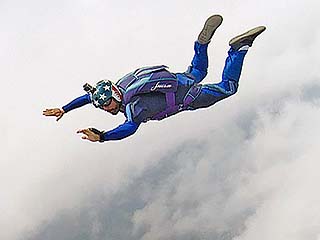
|
Free-fall was without incident, with break-off and parachute opening at about 3,000 feet - Of 10-15 seconds after exit. |
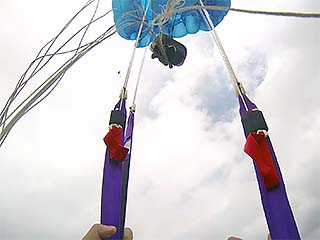
|
When I opened at the intended deployment altitude, the all-to-familiar "jerk" of the parachute opening didn't happen. Basically nothing was out, and I began executing my emergency procedures. Looking up, the deployment bag was the only thing that came out (bag-lock) with the reserve also deploying. This is a HIGH SPEED malfunction, requiring immediate action. |
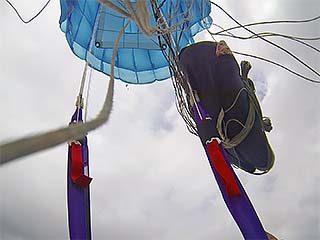
|
Yes, I know - I maybe should have cut away the main, but it remained stowed in the D-Bag. I went right for the reserve D-Handle, and was safely under reserve canopy by 1,900 feet. Basically, if I did not get the reserve deployed, I would have only had a mere 12 seconds before impacting a corn farm. |
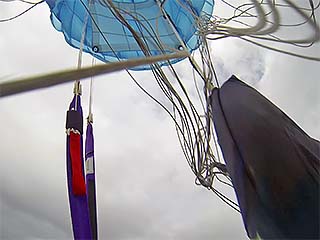
|
The deployment bag falls and I catch it, and stuff it between my legs, and begin piloting the blue reserve canopy to a safe landing area on the far east side of the drop zone. |
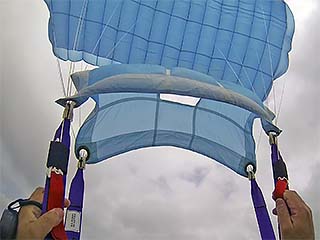
|
Steering my reserve canopy (the main, still safely in the D-Bag, is held between my legs to prevent it from deploying until I safely land south of the grass runway on the east side of the Chicagoland Skydiving Center drop-zone. |
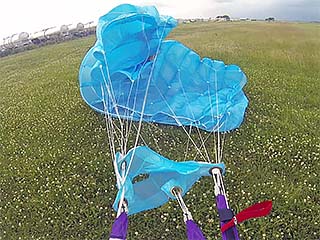
|
Safely on the ground. This was my first reserve ride - On my 761st skydive. |
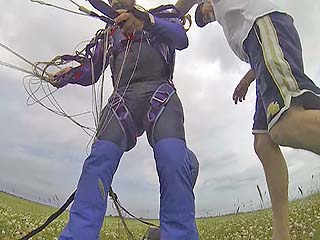
|
One of the folks rushes out with a golf cart, and helps me gather up all my equipment. |

|
Pat on my shoulder for handling my situation as I am de-briefed on what I should / should not do if this happens again. |
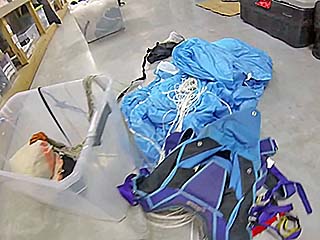
|
Dropping off my equipment in the rigging loft. I lost the reserve free-bag and D-Handle (an extensive search in the corn-fields around the drop-zone did not find anything), which was over $300 for replacement and reserve re-pack. Fortunately by not cutting away, I managed to keep my main and D-Bag (that alone would be almost $2,000 to replace). |
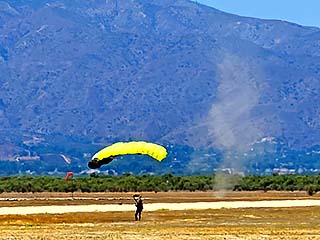
|
Dust devils are small vortices (similar to tornadoes) that occur on hot (usually dry) days. These are to be avoided by anyone under canopy. A dust devil can cause a deadly accident by slamming one into the ground and / or collapsing the canopy - Especially since they occur at low levels and during the crucial phases of skydiving (landing). |

|
When jumping ends for the day, the "beer light" comes on. Any "first" event in skydiving, from your first solo, first reserve ride (yes I was honored to get the folks at CSC a case of beer), to feats, landing on pavement, and even broken bones - Constitutes the "beer line", where one must buy a case of beer for the skydive facility. And, just so you know, a "case" is 24 beers, preferably strong ones, and from a reputable brand (such as Heineken, Corona, etc.)! |
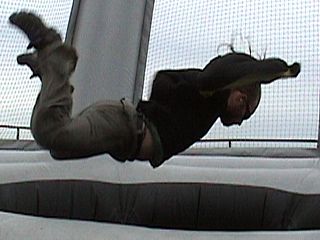
Skydiving is most enjoyable and exhilarating when leaping from an airplane at altitude and free-falling until a parachute is opened to slow the rate of descent back to earth for a safe landing. For many people, the thought of jumping from an airplane miles above the ground is way too much to even contemplate. For avid skydivers, there are also rainy days and gear to pack. A solution to such "cons" of REAL skydiving is a skydiving wind tunnel, or VWT (Vertical Wind Tunnel).
A vertical wind tunnel, refered to as VWT, is simply a low speed (subsonic) wind tunnel where the test / flight chamber is oriented in a vertical position (usually with the wind blowing upwards). These machines have been around for a while, but only recently have been perfected and fine tuned for performance and comfort. Best of all, they offer the same aerodynamics as a human experiences in free-fall and therefore provides a great learning / training environment, with no rainy days, no rigs to pack, and that anyone can do in complete safety.
Even experienced skydivers can benefit from the VWT. Flying in the narrow updraft provides some special challenges to precision fying, especially holding a body position - Important for any skydiving discipline. For inexperienced jumpers, or first-timers, a VWT can give the feeling of freefall with the anxiety, fear-of-heights, and cost removed from the equation, to name a few. In a nutshell, a VWT works by creating a powerful updraft using a fan or propeller apparatus. This vertical wind is anywhere from 80 to 145 MPH, depending on the VWT capabilities and skill-level of the jumper. Instead of the jumper falling through the air at terminal velocity, in a VWT the air is moving, causing the jumper to hover (or "float") on that air stream. The updraft must be the same speed as the relative wind would be in free fall to reach equilibrium (equivalent to terminal airspeed).
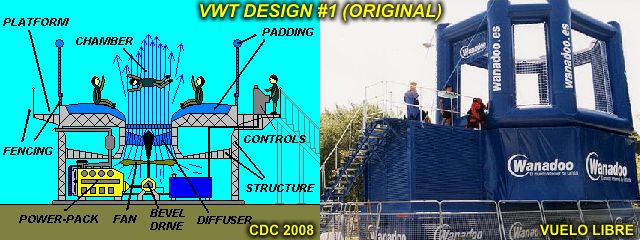
Vertical wind tunnels have had many designs when they first started out. The original was invented by taking a large propeller, driven mainly by a diesel engine, to produce an updraft sufficient to "float" a jumper. An excellent example of this setup can be seen down below in the SUMMERFEST section where the HURRICANE I VWT is shown. Like the diagram above, the left schematic shows the setup of such a VWT. These are run outdoors, and feature a platform and padding / netting around the flight "chamber". A gearbox, clutch, and bevel-drive (90 degree gearing) mates the propeller to the engine, which develops at least 600 horsepower. The prop-wash enters a diffuser, to smooth out the airflow and distribute it evenly across the flight area. These VWT's operate at about 80 to 110-MPH, and most are portable units. These can be operated at theme parks, drop-zones, and the like. The disadvantages are exposure to the elements and low airspeeds.
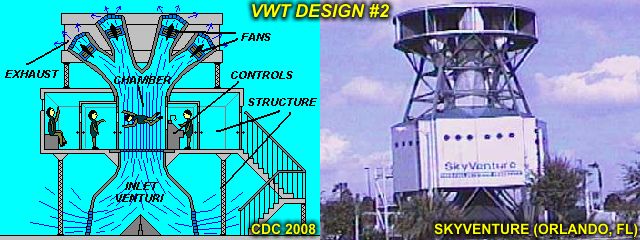
A new and far-more advanced version of the VWT came out in the late 1990's with more engineering (Sky-Venture) for it's specific purpose, rather than just being downwind of a large, noisy, and turbulent propeller. This next design offers a higher airspeed, smoother airflow, and the ability to operate in any weather. The flight chamber is enclosed in a building, which also can include shops, gear, spectator, and training rooms. Instead of the air being blown into the chamber, it is removed from the top, creating a suction which draws air through a venturi and screen at the base of the unit. The eliminates almost all turbulence and allows a strong and steady airstream across the entire flight chamber. Usually 5 (or more) electric fans power the unit, each developing at least 150 horsepower. The exhaust vents to the atmosphere (open system, non-recirculating).
Also - To ease some suspicions - There is NO WAY a person in the chamber can reach the fans via the updraft, due to the shape of the tunnel throat at the top, and lower airspeed due to divergence. Many units have a new synchronous frequency drive to control the motors precisely and quickly change airspeeds. Airpeeds in these units range from 110 to 145-MPH, and can suit any skill level, from beginners to expert free-fliers. The disadvantages of the unit is lack of portability and initial construction costs. Also, although the unit can operate in any weather, temperature is not controlled as it is an open system.

The final design of the next-generation wind tunnel is a modification where a closed loop (recirculating) airflow was incorporated. In this design, the ductwork follows a split path around each side of the flight chamber, without drawing from and venting to the atmosphere. In each split at the top, powerful fans, nearly identical to those used in the second design above, pull air up through the venturi and flight chamber. Vanes on bends in the ducting smooth the airflow and avoid turbulence. The air circulates in a continuous, closed loop. The airspeeds and performance are very similar to the second design above, from 110 to 145-MPH, with the added luxury of heating and air-conditioning! These new re-circulating wind tunnels, being climate controlled, are usually found in cold climates. Also, being a self-contained unit only having to vent stale (or fresh) air to (or from) the atmosphere, the system can be enclosed in a building, either by itself, or inside a mall or hotel. The disadvantages of this design are initial costs with construction.
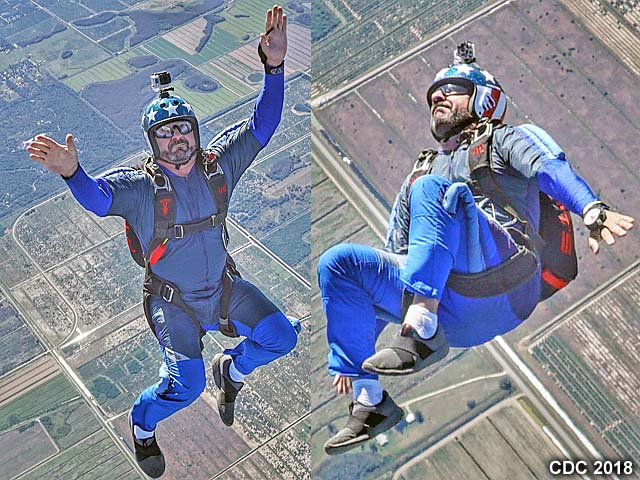
The picture above is two pictures of myself exiting high over Clewiston, Florida and doing a back-loop. Specialy skydives are any jumps that are either "non standard", such as jumping out of a different aircraft (such as helicopters or hot air balloons), and / or pushing the limits, such as high-altitude jumps.
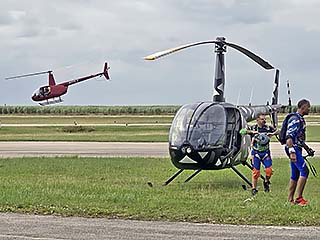
|
R-44 (Robinson 44) helicopter during Skydive Spaceland's Helicopter Boogie in Clewiston, Florida in October 2024. |
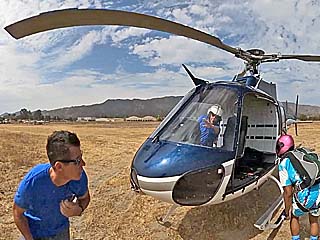
|
This is a Airbus (Eurocopter) A-350 at Lake Elsinore, California in July 2021. This holds about 4 jumpers, taking them to 9,000 feet before dropping them. |
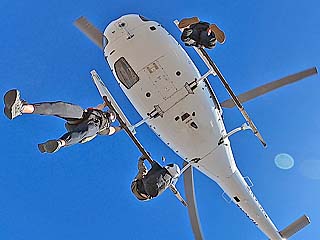
|
Rather "sketchy" exit from the Airbus (Eurocopter) A-350 high over Lake Elsinore, California in January 2021. This is a dangerous activity due to possible snag points on the helicopter skids. I let go first and I am lookin up at the other 3 jumpers hanging off the helicopter skids! |
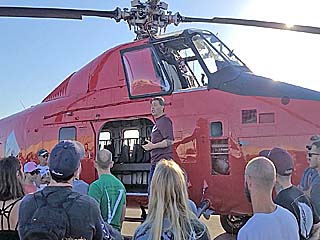
|
Ground briefing prior to an awesome jump out of a Sikorsky "Screaming Mimi" 58T helicopter in Perris, California in August 2021. This can bring 9 jumpers plus two crew to 6,000 feet in just 3 minutes (twin Pratt and Whitney gas turbines producing nearly 2,000 shaft HP). |
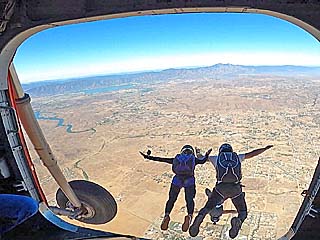
|
Two jumpers exiting out of the Sikorsky 58T helicopter 6,000 feet over Perris, California in August 2021. |
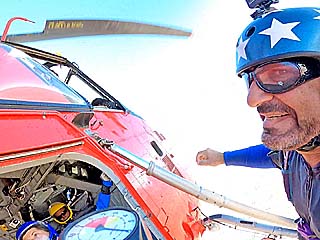
|
Myself backwards-exiting out of the Sikorsky 58T helicopter 6,000 feet over Perris, California in August 2021. |
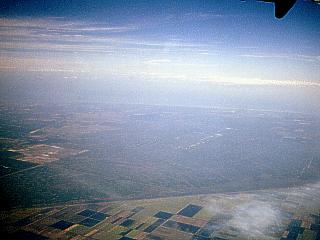
|
This picture may look like most pictures taken from a jet airplane. Actually, that was not the case. Here I was doing high altitude skydiving at Pahokee's Skydive Palm Beach and took a picture just before un-donning my oxygen mask and exiting the Super DH6 Twin Otter at an altitude of 24,000 feet. At this height, both coasts of Florida could be seen from directly over the eastern side of Lake Okeechobee. In this picture, the east coast of Florida, 50 miles away, stretches from north of St Lucie, through Stuart, and West Palm Beach from left to right. Note the slight curve of the Palm Beach coast. The small haze streaks below are sugar cane smoke plumes. The dark area under the white cloud in the far upper-right portion of the picture on the horizon is the west end of Grand Bahama island! |
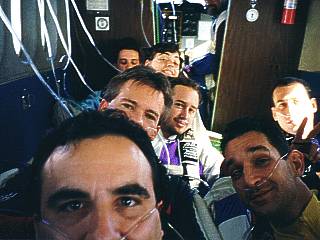
|
This picture was a quick one I took of myself, lower left, and the rest of the group of skydivers while climbing through 21,000 feet on the way to our exit altitude of 24,000 feet in a DH6 Super Twin Otter. Everyone on this load is apparently breathing pure oxygen through a nose cannula. We were required to breathe oxygen from before takeoff until immediately before exit. At 24,000 feet, not only will you pass out in a minute or two, but the rapid ascent could cause a mild bends if not enough nitrogen is "flushed" out of your system before and during the rapid climb to altitude. The new PT6A-34 750HP engines took the Twin Otter to 24 grand in only 18 minutes! Outside air temperature - A polar 25 below. |
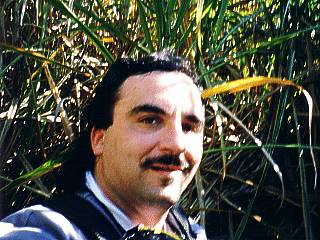
|
Here is another self-picture of myself deep in some sugarcane somewhere between Bell Glade and Pahokee after jumping from 24,000 feet. This was the first load and jet stream winds of over 60 knots do a pretty good job at moving skydivers during a 120 second free-fall. Myself and 4 others landed about a mile or two southeast of the drop zone. Landing in sugar can was quite hair-raising because the stalks were 10 to 12 feet high and the only way to land there was to flare your canopy AFTER passing the tops of the stalks ... PLF anyone? Speaking about "Cane in the crotch", Ever land in sugar cane? |

|
Here is a picture of the aircraft (DHC-6 Twin Otter) to the upper right, and the scenery (including thunderstorms from developing tropical storm "Claudette") during a high altitude (civilian HALO) jump (abpout 22,000 feet) over Clewiston, FL on August 16, 2009. Despite the air temperature on the ground near 85 degrees F, the temperature at exit altitude is at least 20 BELOW, literally a temperature change of over 100 degrees, all experienced in the 100+ second free-fall. Note the darker blue sky. |
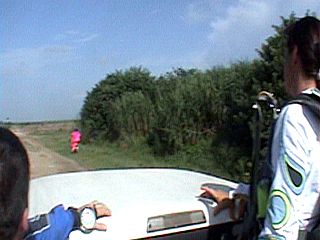
|
Another picture of an "off landing" after a high altitude jump (22 to 24 thousand feet) over Clewiston in August 2009. At such high altitudes, the higher true airspeeds of the aircraft on jump run become so high that any hesitation on exit groups can "throw" jumpers far from the exit point over the drop zone. In this picture, jumpers exiting last had to be picked up from a farming area a mile or two southeast of the drop zone (Airglades airport). |
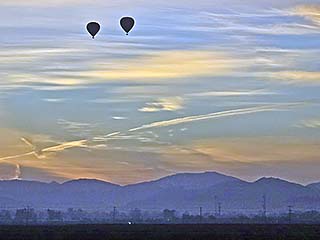
|
Two hot air balloons, carrying skydivers, rise over Perris Valley at dawn on October 26, 2024. |
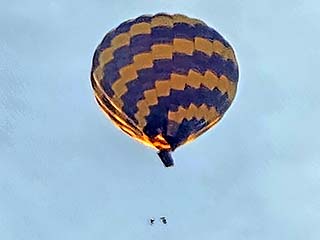
|
Two jumpers exit one of the balloons while over Skydive Perris as I am eating breakfast. |
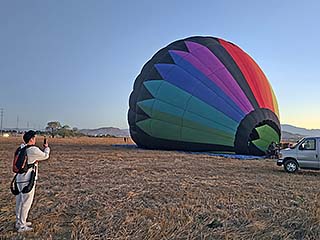
|
Filling one of the hot air balloons (provided by BalloonSkydive.com) about a mile from Perris Skydiving. |
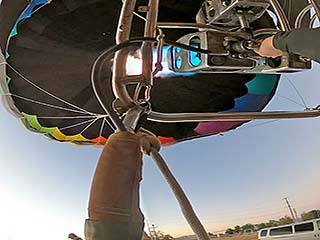
|
Firing up the burners in order to take skydivers to altitude on a cool morning just before dawn. |
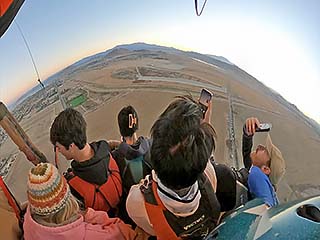
|
Liftoff around dawn. |

|
Sunrise puts a smile on my face as we ascend to jump altitude (around 5,000 feet AGL). Some foreign jumpers come a long way to the USA to do this. |
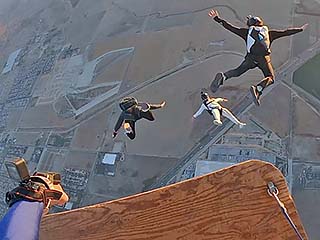
|
First 3 jumpers exiting. |
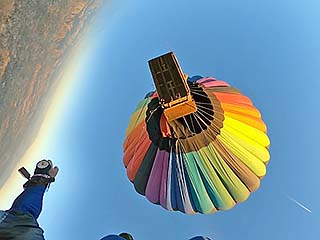
|
View from my helmet camera just after exiting into completely "dead" air. I tumble forward until airspeed quickly builds to terminal. |
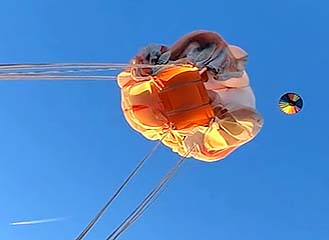
|
Parachute opening at about 3,000 feet AGL - After about 15 seconds of free-fall. |
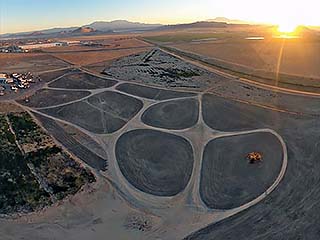
|
Perfect "spot" right over the Perris drop-zone! Coming in for landing on the green grass on a frosty morning (higher up, the temperature was much warmer, due to a cold air inversion). |
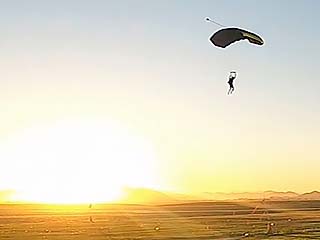
|
Another jumper landing in front of the sunrise at Perris Skydiving. |
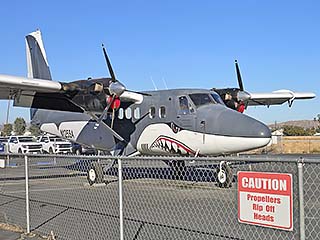
|
DH-6 Twin Otter - In their "shark" livery. |
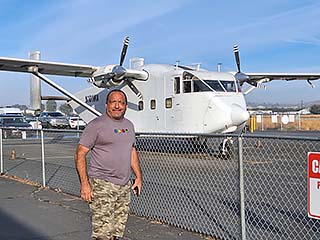
|
Shorts 330 "SkyVan" - Skydive Perris is a full time major drop zone with at least 4 standard aircraft operating year round. |
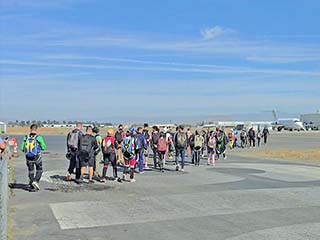
|
At least 80 jumpers walking out to board the DC-9 jet airliner during their jet jumps on October 26, 2024. This is the only commercial jet airliner used for skydiving - And is operational once again after being down / grounded for over a decade. |
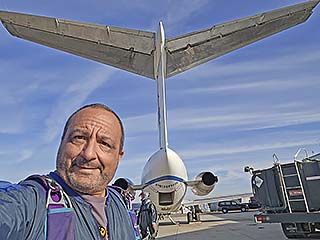
|
Myself and the rear of the DC-9, with twin JT8-D (Pratt and Whitney) engines and exit rear air stairs! |
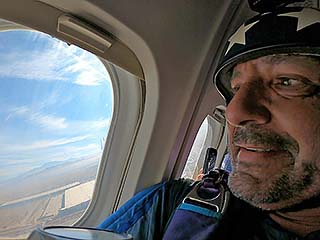
|
Fast takeoff aboard the DC-9 with everyone in full skydiving gear (funny to see that in an airliner)! Time to 15,000' MSL was just over 4 minutes. |
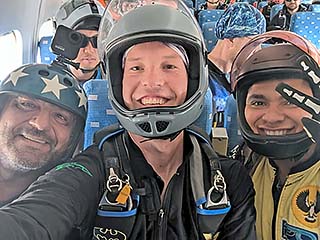
|
My group of skydivers including myself during the ride to altitude. |
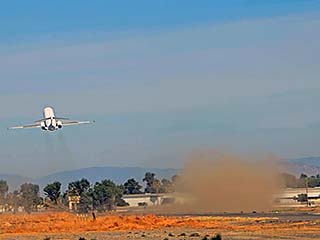
|
Ground shot of DC-9 taking off, with jet blast kicking up dust. |
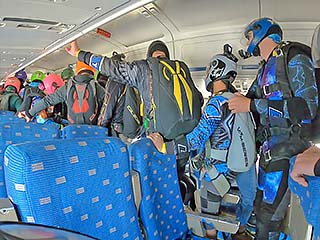
|
One pass, single file, don't hesitate, and run it out the rear exit - The 200 MPH ground-relative speed should help with the "separation"! |
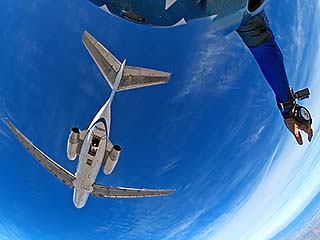
|
Once out and clear of the rear air-stairs, your blasted with the 130 KIAS+ free stream and quickly slow down to normal terminal velocity. You can feel the heat and roar of the engines. |
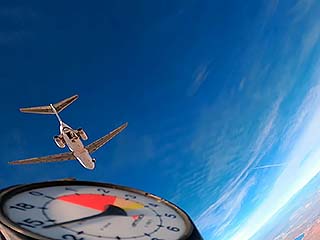
|
Another view of the DC-9 after exit and deceleration. |
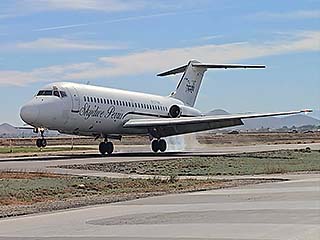
|
Ground shot of the DC-9 touching down after a jet jump. |
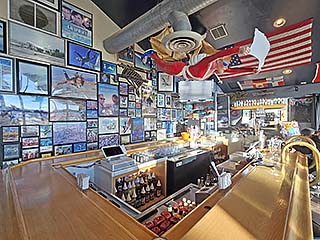
|
Shot of the "Bomb Shelter" bar and cafe at Skydive Perris. Many movie stars jumped here, even Patrick Swayze back in the day (he's on the wall there). Perris even has a swimming pool. |
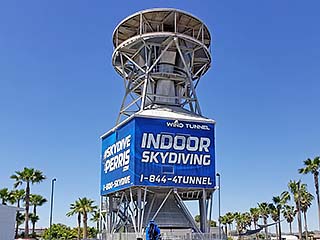
|
Vertical wind tunnel at Skydive Perris. This is one of the second generation (2nd design) "open" types, described above in my section on wind tunnels. |
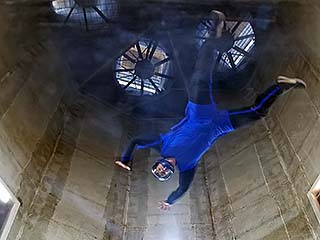
|
Skydiver having fun in the powerful updraft inside the chamber of the vertical wind tunnel. |
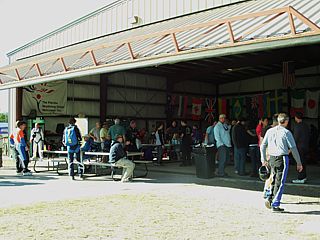
|
The "Great White North" boogie is a small skydiving boogie that is usually held each year at the Florida Skydiving Center in Lake Wales, Florida in mid January. This event gives those tired of the cold winter up north to come down to Florida and enjoy skydiving in a warm climate. On this day (January 17, 2009) the weather was just about perfect and there was a great turnout, friendly crowd and great vibe. |
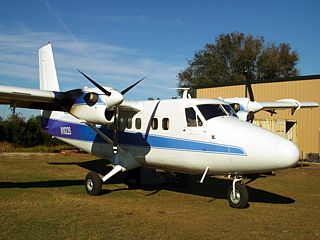
|
Here is a picture of a De Havilland DH-6 twin otter at the Florida Skydiving Center, one of three aircraft in use, during the Great White North boogie event. |
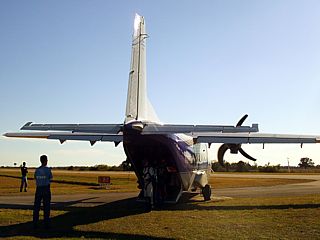
|
This is a picture of the C-212 CASA being used during the Great White North boogie in Lake Wales. The CASA is loaded with 25 jumpers and is taxiing for takeoff. |
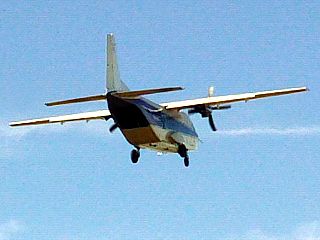
|
The C-212 CASA, loaded with 25 jumpers, takes to the sky over Lake Wales en-route to 14,000 feet on a pristine and clear day in central Florida. |
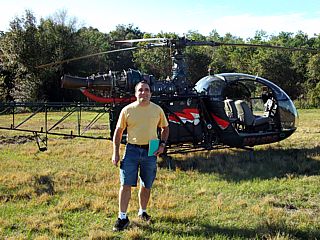
|
This is a picture of myself standing in front of an Alouette II helicopter at the Great White North skydiving boogie in Lake Wales. I actually got to jump out of this vintage helicopter while hovering at about 4,500 feet. This helicopter is a French design, and powered by Turbomecca 400 HP (gas turbine) engine, which can be seen in it's entirety between the rotor mast / bevel-drive transmission and the tail of the helicopter behind my head. This helicopter carries 4 jumpers (plus pilot) to 4,500 feet in roughly 3-5 minutes. |
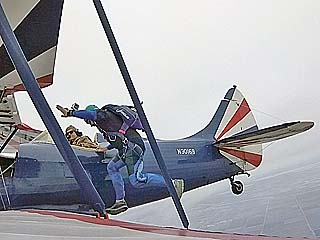
|
Wing-mounted camera picture of me exiting a WACO bi-plane over Clewiston, Florida in January 2018. |
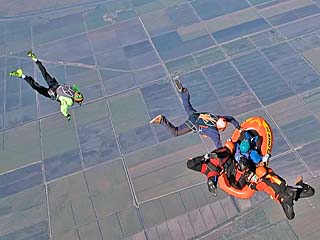
|
Raft jump (from a Shorts Skyvan) over Clewiston, Florida in January 2018. Photo by Jason C. |
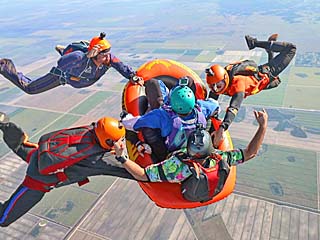
|
Closer view of the raft jump (from a Shorts Skyvan) over Clewiston, Florida in January 2018. I am in the raft to the rear. Photo by Jason C. |
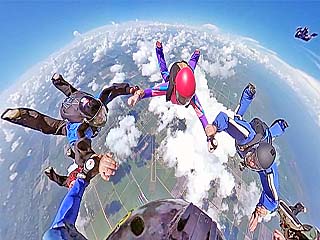
|
Jumping together in a 10-way formation over Clewiston, Florida in January 2018. |
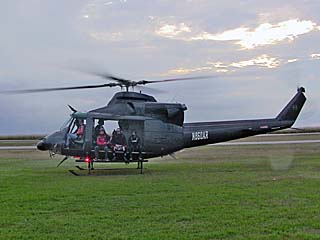
|
Bell 412 helicopter with twin Pratt and Whitney engines to skydive out of in January 2018 in Clewiston, Florida. |
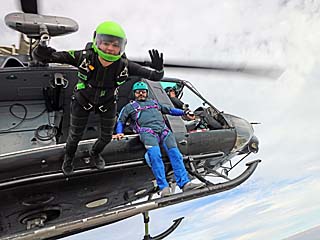
|
Exiting the Bell 412 helicopter over Clewiston, Florida in January 2018. Photo by Jason C. |
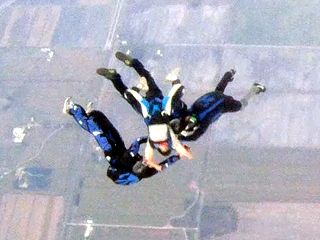
|
Here is a view of a group exit from the tailgate ramp of the Skyvan at about 14,000 feet during the Boogie over the Everglades event at Air Adventures in late January 2012. |
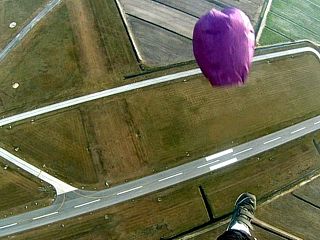
|
I was wondering what this little purple "unidentified flying object" was when I encountered it roughly 2,000 feet over Airglades airport while under canopy after jumping from nearly 20,000 feet on the early morning high-altitude jump in January 2012. It is a paper Chinese lantern, floating up through the cool morning air with a little fire in its base providing hot air to lift it. I was actually able to kick it with my right foot! |

|
This is one of many open canopies flying past the partial moon after the sunset jump from the Skyvan at the 2012 Everglades Boogie at skydive Air Adventures near Clewiston, Florida during the early evening. |
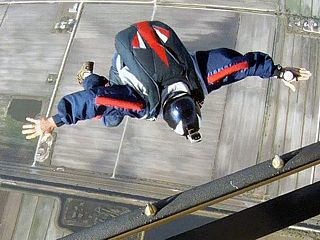
|
Here is a shot of a fellow jumper stepping off the skid of a Bell-407 jet helicopter and into the weightlessness of the still air roughly 5,500 feet over the north landing area near the entrance of Airglades airport at the 2012 skydiving Boogie over the Everglades. |
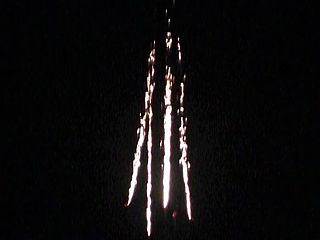
|
Look up in the night sky! Is it a bunch of shooting stars? It's actually the US Army's "Black Daggers" skydiving team exiting a Pilatus Porter aircraft 14,000 feet above Airglades Airport on a late evening in January 2012 with pyrotechnics ablaze! Although an off-target spot and landing, this demonstration group still made a beautiful formation with firey trails of smoke and sparks during their one-minute night freefall jump under a partial moon. |
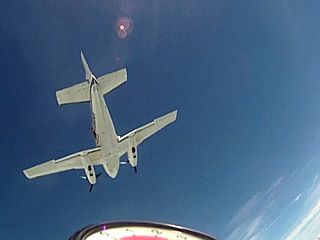
|
This is a picture taken from a wrist-mounted GoPro "Hero" HD camera just after exiting the King Air 13,500 feet over Clewiston. The GoPro "Hero" camera is a small tape-less HD camera that can be mounted on a helmet, leg strap, arm-band, etc for a very unique perspective of skydiving (and other extreme activities as well). |
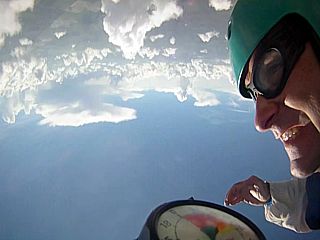
|
Here is a picture of myself doing a back-loop while flaring out of a 165-MPH head-down dive. The wide-angle view of the GoPro "Hero" HD camera allows myself to be included in many of the shots. |
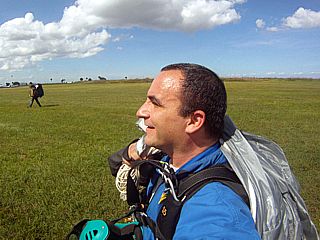
|
Here is another view of myself just after landing, shot with the wrist-mounted GoPro "Hero" HD camera. |
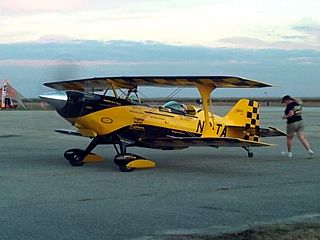
|
Here is a picture of a Pitts Special aerobatic bi-plane, flown by Fred Cabanas of Key West, flying jumpers to 5,000 feet for inverted bi-plane jumps - Yes, we actually jumped from this plane, after a serious of high-G aerobatics! The Everglades Skydiving Boogie was held again in 2009 (for the second year in a row) from January 23-25, 2009 at Air Adventures (near Clewiston, Florida). This year had fantastic weather, 3 large jump planes (2 Otters and a Skyvan), a Pitts Special (shown here), Bell 412 helicopter, and L-39 jet for rides! |
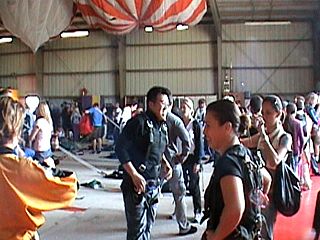
|
The Everglades Skydiving Boogie is held in late January. In 2008 it was held during the weekend of January 25-27, 2008 at Air Adventures (near Clewiston, Florida) and was the first such event held there since 2002 (and the largest ever). Turnout was excellent, and all aircraft and logistics went well (although hectic), with good weather for the most part. The picture shows what the main hangar and packing area looked like on January 26. The skydiving aircraft line-up included 3 DH-6 Super Otters, a Shorts Skyvan, UH-1 "Huey" helicopter, and hot air balloons. Aerobatics were also offered in an Extra-300 and an L-39 jet fighter (sorry, you could not jump from these). Saturday evening was topped off with food, beer, and music. |
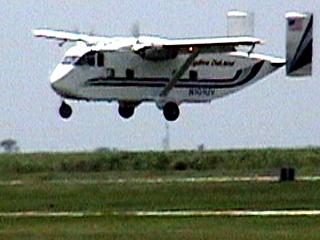
|
The Skyvan comes in for a final landing after dropping nearly two-dozen jumpers at the "Liquid-Sky" boogie that was held from July 18-20, 2008 in Clewiston, Florida. |
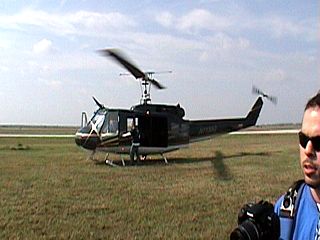
|
Here is the helicopter, a UH-1 "Huey" used for making skydives as the Everglades Boogie. This is the same helicopter so popular during the Vietnam War (in this case, it WAS one of those same choppers). The chopper quickly reaches 6,000 feet or so to drop about 8 jumpers! |
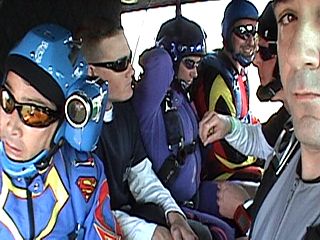
|
Here is a view of the load on the UH-1 helicopter during the ride to altitude. I am to the far-right. I shot video of this jump via a helmet-mounted camcorder. |
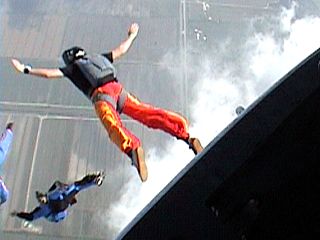
|
The first group of 3 jumpers steps out into the near still air of the UH-1 at 6,000 feet. The experience of jumping from a helicopter in hover is MUCH different than that from an aircraft. You feel that "stomach turning" feeling because of the initial weightless condition you get when you first jump (before rapidly accelerating to terminal velocity). |
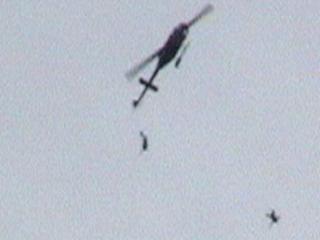
|
Here is another picture (taken from the ground), of two jumpers exiting another helicopter - A Bell 206 Jet-Ranger, at an altitude of about 5,500 feet during the July 2008 "Liquid-Sky" boogie. |
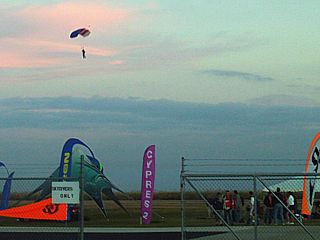
|
The sun sets after a great day of skydiving at the Everglades Boogie in 2009 as some of the last jumpers from the "sunset load" land. |
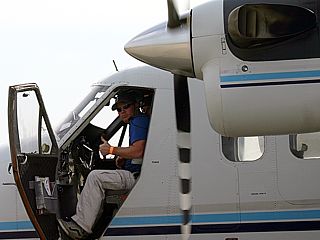
|
One of the pilots gives a thumbs-up before taking a load of jumpers to altitude in a DHC-6 Otter at the Everglades Boogie in Clewiston in 2011. |
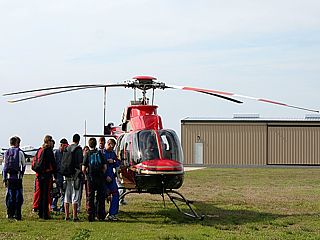
|
One of the jump aircraft at the 2011 Everglades Boogie in Cewiston, FL was a Bell 407 helicopter. This is a unique skydiving experience because you exit the aircraft while hovering at over a mile above the ground, and get to hear and feel the vertical acceleration (including the "butterflies") from 0 to 120 MPH before opening the parachute around 3,000 feet. |
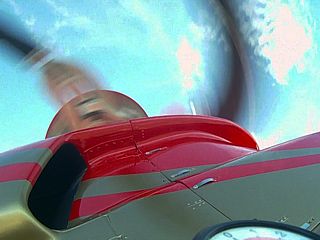
|
Interesting view right above my head prior to exiting the Bell 407 helicopter of the main rotor mast. Picture taken during the 2011 Everglades Boogie. |
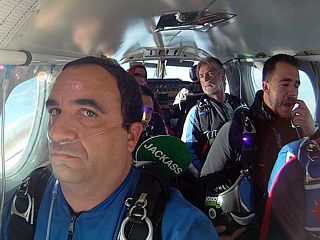
|
Here is a picture of the jumpers inside the King Air with oxygen cannulas while climbout to a 22,000 feet MSL exit altitude during the Everglades Boogie in 2011. Without oxygen, jumpers will pass out in less than 8 minutes above 20,000 feet. |
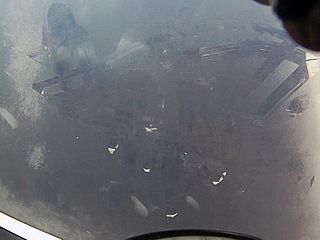
|
Here is a view of the sliding exit door of the King Air while climbing through 20,000 feet en-route to a 22,000 foot exit altitude. That's a thin coating of ice on the plexiglass, with an outside temprature approaching nearly 30 degrees below zero and a head-wind of about 100-MPH. Picture taken during the 2011 Everglades Boogie. |

|
Here is a shot of the view looking straight down just before exiting the King Air from a 22,000 foot altitude over Clewiston's Glades airport during the 2011 Everglades Boogie. Note the first jumper who exited to the lower left. Yes, that first step sure is a LONG one - Like 4+ miles of pure falling! |
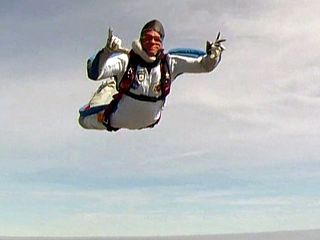
|
Fellow skydiver "orbiting" around me at about 7,000 feet after jumping from 22,000 feet at the Everglades Boogie in 2011. |
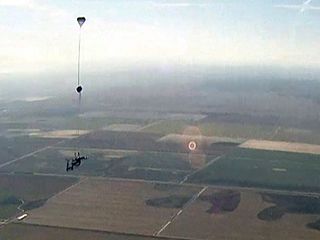
|
Here is a cool shot of another jumper opening his parachute next to me at 2,500 feet just as I was opening mine after a skydive from 22,000 feet. Note how the pilot chute pulls the main "bag" container out via a long cord called a "bridle". The main parachute is in the "bag" and is deployed once the pilot chute pulls out the main parachute, allowing it to inflate. Picture taken during the 2011 Everglades Boogie. |
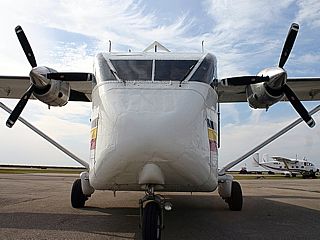
|
Here is a picture of the front of the Shorts Skyvan just before a skydive from its tail gate during the 2011 Everglades Boogie. Another skyvan can be seen in the background. |
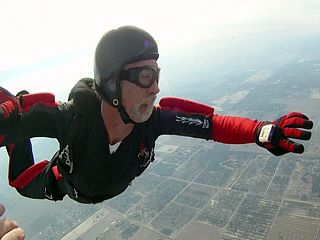
|
Here is a picture of a fellow skydiver jumping with me on a successful two-way RW jump from the Skyvan during the Everglades Boogie in January 2011. We completed about three docks and are about to wave-off and track away at 5,000 feet to open at 3,000. |
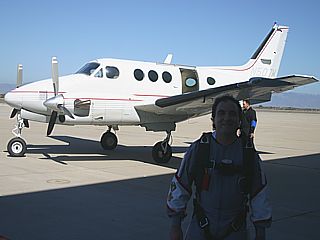
|
Here is a picture of myself at Skydive Monterey Bay in Marina, California getting ready to jump the King Air (background). The King Air is the B-90 series Beechcraft / Raytheon aircraft and is powered by two Pratt and Whitney PT6A-34 turbo-props that produce 750-HP each. |
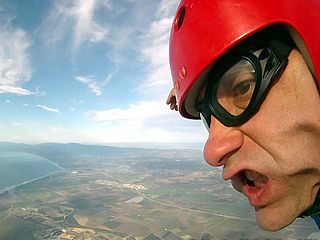
|
Here is a picture of myself at Skydive Monterey Bay in Marina, California in free-fall from 18,500 feet with the California coast in the background as I am buffeted by the slip stream. The image was taken from a GoPro "Hero" HD camera mounted on my wrist. |
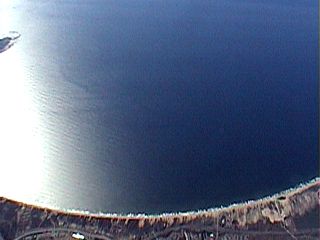
|
The first skydive from the King Air was from an altitude of about 19,000 feet. Skydive Monterey Bay consistently provides skydives from at least 18,000 feet, including supplemental oxygen. The view of the Pacific Ocean and surrounding Monterey Bay from such heights is awesome! |
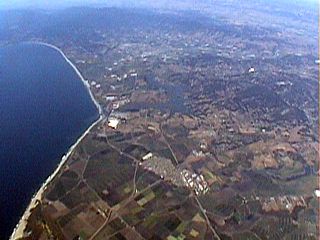
|
Here is another picture, taken at jump altitude of 19,000 feet just after exit, from a helmet-mounted camera, looking NNW. The view stretches from distant San Francisco and "Silicon Valley" to the far upper-left downward through Santa Cruz and Moss Landing along the coast to the left. |
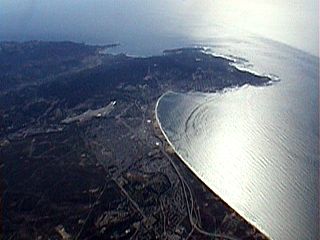
|
Looking SSW from near jump altitude, the entire Monterey Penninsula can easily be seen extending out into the Pacific Ocean. From 19,000 feet (with a 3,000 foot parachute opening altitude), the free-fall takes nearly 90 seconds! |

|
The second jump was an attempted 10-way. In this picture, four of us are holding hands in formation after exiting at 18,000 feet over Marina near Monterey Bay, California. The intent was to build a 10-Way as 6 other jumpers exited behind our "base" and attempted to dock with us. This discipline is called RELATIVE WORK, or RW. |
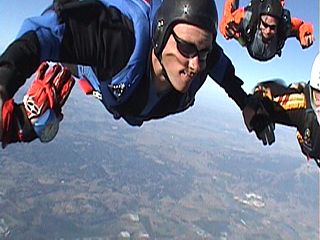
|
The 10-Way RW formation builds above the fabulous 3.5 mile-high view stretching from San francisco to Bakersfield. Note the 120-MPH wind effects on the man's face across from me! |
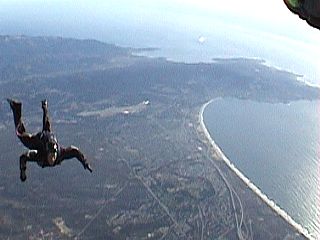
|
Another "floater" (skydiver) attempts to make his way to the building 10-way with the Monterey Bay penninsula and Pacific coast as the back-drop. This semi-successful 10-way involved the initial 4-way base, 6 docking with us to form a 10-way "star", then half the formation to split into their own "star" formations, do 1 complete rotation, and re-dock. Break-off was 5,000 feet. Total free-fall time was an awesome 85-90 seconds, 70 of which available for pure RW! |
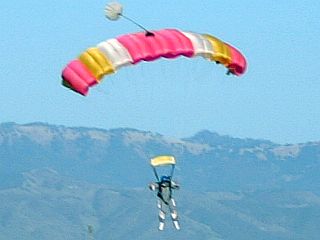
|
This is a picture of myself making a final approach at the landing area at Skydive Monterey Bay in California. |
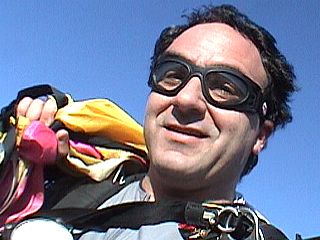
|
Here is a self-portrait of myself right after landing and completing a great 10-way attempt in hign spirits. |
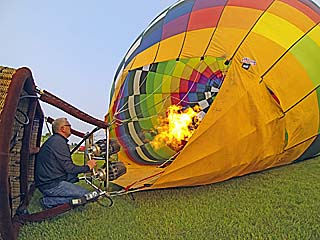
|
Inflation of a hot air balloon for skydiving at the 2015 Independence Boogie in early July 2015 near Rochelle, Illinois. |

|
Two jumpers exit the hot air balloon over Rochelle, Illinois during the 2015 Independence Boogie in July 2015. |
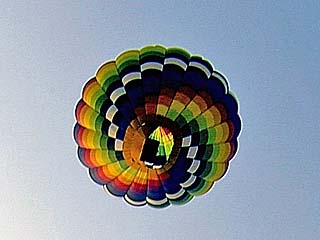
|
My view looking up during multiple back-flips off the hot air balloon during the 2015 Independence Boogie over Rochelle, Illinois! |
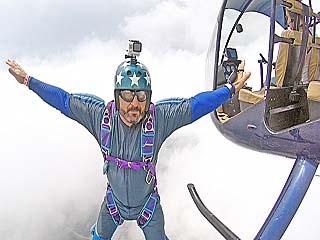
|
Exit off a R-44 helicopter during the 2019 Independence Boogie over Rochelle, Illinois in early July. |
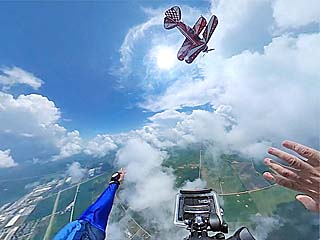
|
Exiting Pitts Special bi-plane over Rochelle, Illinois during the 2018 Independence Boogie in July 2018. |
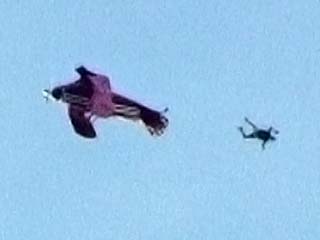
|
Ground view of a jumper exiting a Pitts Special bi-plane over Rochelle, Illinois during the 2018 Independence Boogie. |
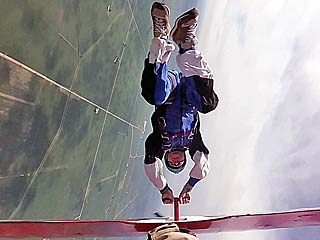
|
Plane-mounted view of myself in a zero-G roll prior to exiting a Pitts Special bi-plane over Rochelle, Illinois during the 2016 Independence Boogie in early July. |
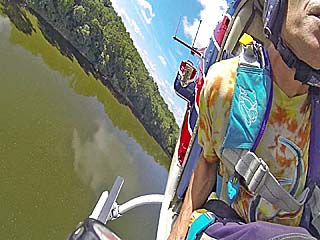
|
Flying low over the Fox River out of Skydive Chicago aboard a Bell 206 Jet Ranger helicopter before climbing to altitude for a helicopter skydive in August 2016. |
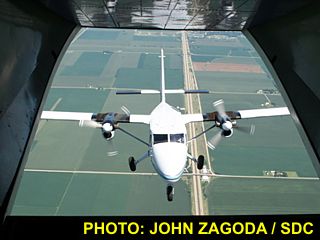
|
Here is an AWESOMNE shot of a De Haviland Otter just feet under and behind a CASA during the 2008 Summerfest Boogie at Skydive Chicago in August 2008. Photo is coutesy of John Zagoda and it shot right out the tailgate of the CASA during the climb-out! |
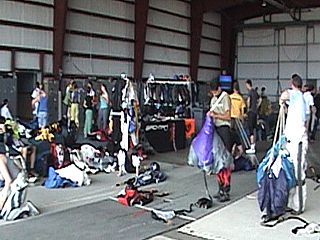
|
Here is a picture of the main hangar at Skydive Chicago on Saturday, August 4, 2007. During the Summerfest 2007 boogie, this place was a bustling and lively gathering of packers and skydivers from dawn to dusk. |
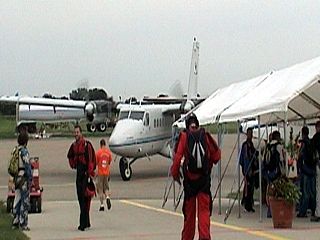
|
A Dehaviland Twin Otter (DHC Dash-6) was one of several "standard" jump aircraft available at the Summerfest 2007 boogie. The Twin (turboprop) Otter is awaiting the next load of jumpers in the aircraft staging (loading) area. |
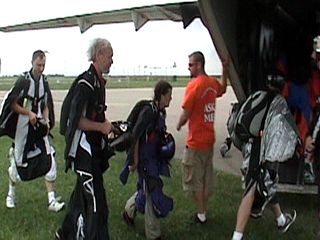
|
A group of wingsuit fliers boards the tailgate ramp of a CASA C-212 aircraft to do a "flock" wingsuit dive. The CASA is a popular Spanish cargo plane featuring twin turboprops and a cargo ramp at which jumpers exit off of at altitude. |
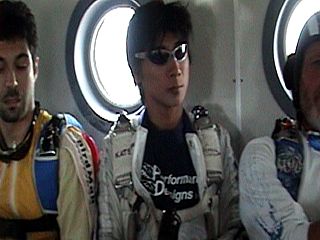
|
Here is a picture of how jumpers sit in the CASA while waiting for the ride to altitude, which can be anywhere from 11,500 to 14,500 feet, depending on conditions. Today we only made 11,500 feet due to clouds and rain / sleet aloft. The jumpers sit on foldable benches on opposite sides of the fusalage. This is called the "paratrooper configuration" of such an aircraft. |
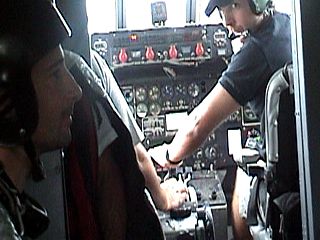
|
The CASA has a pilot and co-pilot in the left and right seats, respectively. The throttles of both 925-HP turboprops are advanced and the aircraft begins its takeoff roll. |
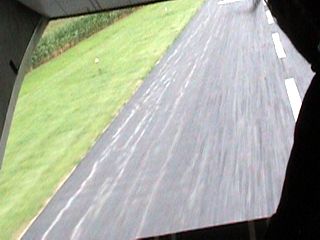
|
Cool view out the tailgate as the nose of the CASA rotates upwards at takeoff and the ground / runway appears to "drop away". |
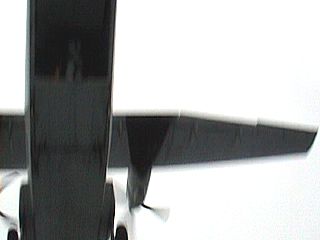
|
My exit from the tailgate of the CASA was a backwards "Nestea-Plunge" off the ramp. Falling backwards then rolling up tight, I complete about 4 back-loops. This picture, taken from video from a camcorder mounted to my helmet, shows the back of the aircraft after about the first backloop. The picture is a big blurred, but if you look closely you might see some other jumpers watching me from the tailgate. |

|
Here is another picture taken from the helmet-camcorder video. In this picture, the ground is at the top and to the right as I was in an upside down attitude during my skydive. The sky is brighter but a light rain / snow mix was falling near exit altitude. |
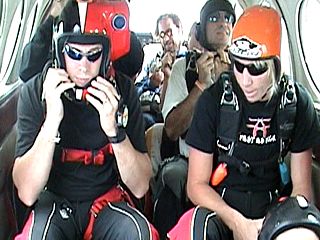
|
Here is a picture of the group of jumpers aboard a Beechcraft / Raytheon King Air 100 getting ready to exit the aircraft at about 12,000 feet. |
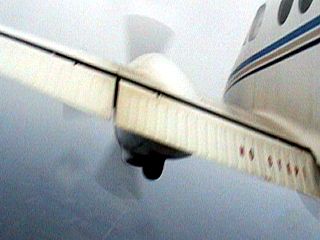
|
I was the first one out the door of the King Air, and this video frame-grab was taken about 1-2 seconds after exiting the King Air. The left (Port) turboprop and front / side of the aircraft can be seen from this unique perspective (before gravity really kicked-in)! The sky and ground appear "wet" because a cloud deck was present at about 12,000 feet. The colder air aloft made for a cold rain / sleet / snow mix that evaporated before reaching the ground (called "virga") but made for a painful "prickling" of the face in free-fall at 120-MPH. |
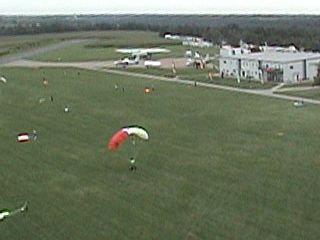
|
Coming in for a landing under my 220 square-foor ram-air canopy at the landing area at Skydive Chicago. Pattern was left-hand approach, and another jumper ahead of me has just touched down. |
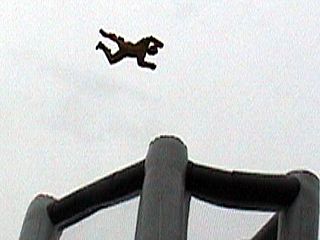
|
Here is a picture of a skydiver flying high on a powerful updraft of air created from the "Hurricane I" portable wind tunnel. So called "tunnel flying" is not as easy as it looks. It requires skill and control to not only learn to skydive, but to stay on top of the rising air column without falling off the edges of it. The unit is trailor mounted and self contained and features a platform, inflatable cushions around the "flying area", a large power plant (Diesel engine), and propeller to produce the high-speed wind. |

|
This is anotther picture of a person in the vertical wind tunnel. The advantage of this unit is that you can fly with no parachute, no rigs to pack, and no "rainy" days. As mentioned earlier, body position is paramount and requires great skill. This man seems to have mastered it well. |
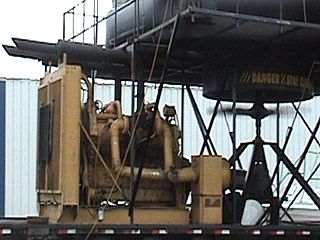
|
Here is the base of the "Hurricane I" machine showing the powerplant (a 650-HP Diesel engine) with a three-bladed propeller being spun to produce a 120-MPH updraft through a ducting and into the "flying area" above. Note the drive shaft from the engine clutch that turns the prop via a bevel-drive gear box. The sound of this equipment was absolutely deafening, and my ears rang for hours after being this close to it (and this was the closest I WANTED to get to it). |
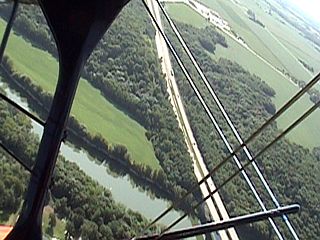
|
One of the "specialty" aircraft to skydive from was a two-place aerobatic bi-plane, a Pitts Special S2-S! In this picture, taken just after takeoff, we can see the river and Interstate 80 east of Ottawa, Illinois through the bracings of the left top and bottom wings. |
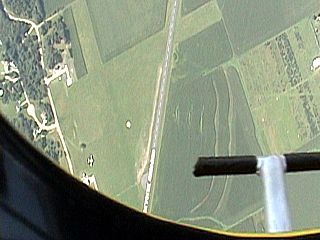
|
At about 5,500 feet above the ground, the pilot begins a series of aerobatics. Aerobatics are available on any of the Pitts special jumps for a mere $20 bucks more - So if you ever are lucky enough to jump this plane, spend the extra option, it's worh it! In this picture, looking over the top wing, we are in a diving attitude (ground right in front of us) and hurtling towards the earth at speeds from 160-MPH to almost 200-MPH. The canopy is removed, and the open cockpit wind noise above 160-MPH is so loud you cannot hear yourself scream. G-Forces, indicated by an accelerometer, reached about 6-G's, so my 200 pound body (including 25 pounds gear) weighed 1,200 pounds! The "T" shaped handle above the top wing center-grip is what I will grab and hold on to when I exit the aircraft and jump. |
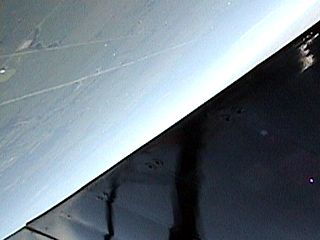
|
Here is another picture of the top wing and ground above us as the Pitts Special is in the inverted attitude during an aileron roll. |
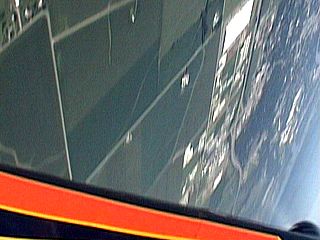
|
To exit the Pitts Special, the pilot gives a thumbs-up signal (the noise makes speaking impossible) and pulls the power back to slow the plane to about 80-MPH for exit. I unbuckle my belt, work my way up from the crammed front cockpit holding the wing grip, then stand on the seat. Putting both hands on the "T" bar means I am ready to go. The pilot rolls the plane in a zero-G half roll to the inverted attitude, where I am now hanging from the "T" bar facing the pilot. In this picture, the plane is about half-way through the inverted roll, and the top of the upper wing can be seen. Exiting while inverted is as simple as letting go of the "T" bar at about 5,000 feet and falling to the 3,000 foot opening altitude. |
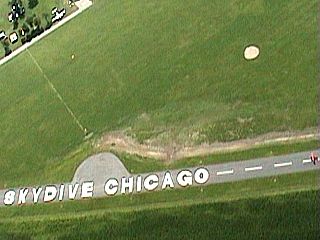
|
Here is a picture, looking down at the Skydive Chicago runway, after jumping out of the Pitts Special and safely under canopy descent. If you look closely, you could see the Pitts Special landing on the runway to the far lower-right of the picture. After exiting the Pitts, the plane went into a steep dive and was near the ground faster than me in free-fall! |
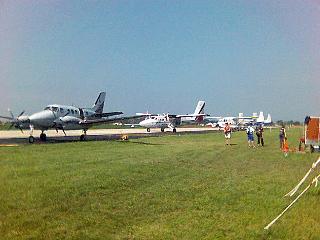
|
This is the main staging area during WFFC 2006 in Rantoul, Illinois. From left to right, we can see Mike Mullin's super King Air, a Super Otter, a CASA, and a Skyvan. Standard jump aircraft varied during this event as well as many "specialty" aircraft to jump from, such as a DC-9 Jet airliner to a Pitts S-2c Special just to name a few! |
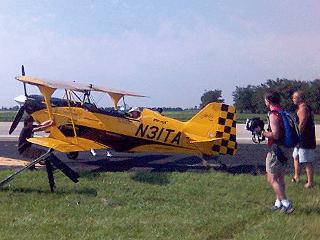
|
Here is a picture of the Pitts Special (S-2C model) owned by Fred Cabanas of Island Aeroplane Tours in Key West, FL. This Pitts Special is brand new (his other Pitts S-2B was lost during hurricane Wilma in 2005) and it is its first time dropping jumpers in Rantoul! Yes, you got it right, DROPPING JUMPERS. Fred, or his other pilot, Gary, would take you up to jump out of the Pitts Special (with or without doing aerobatics first) at about 5,000 feet. The exit, is not for the faint of heart. I know because I did it and with the aerobatics "option" before bailing out! First of all, you are in an open cockpit, so it's loud - very loud, especially in a dive at 185 MPH. When it's time to exit, you have to stand up in the seat (watch those handles!) and grab the "T" shaped bar just above the wing center. The pilot then executes a zero-G parabolic roll as you "float" off the seat and hang from the bar. When you let go, the pilot pushes over to get clear and "voila", you are in free fall! |
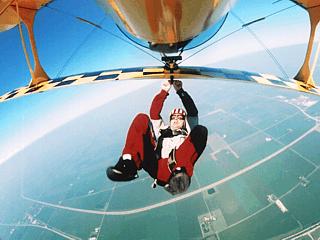
|
Here is the picture of the exit procedure from the Pitts at about 5,000 feet over Rantoul, Illinois. First the plane does a half roll in zero-G to an inverted attitude. The zero-G allows my whole body to "float" up from the seat of the pitts as I hold the center of wing "T" handle. |
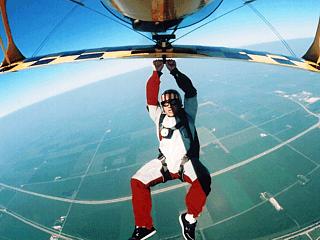
|
In this picture, I am now hanging from the "T" handle and ready to release into freefall as the Pitts pilot holds inverted flight at about -1 G. |
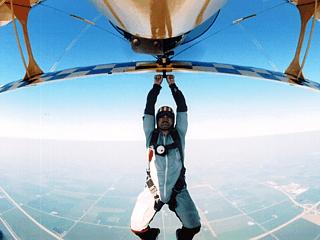
|
Now I begin my count to free fall, out of instinct I shout "Ready ... Set ... Bub-Bye!!" and release the handle. I am thinking "screw drugs - glad I never did them - this is better"! |
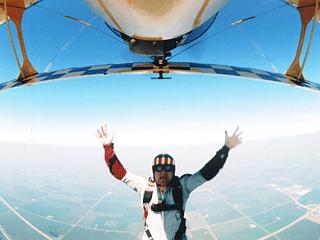
|
Handle released, gravity takes over, and I am clear of the aircraft followed by a 15 second freefall to 2,500 feet (basically a normal skydive, when you get clear of the Pitts). In free fall, the Pitts actually passes me in a dive, what a sight! What an experience! |
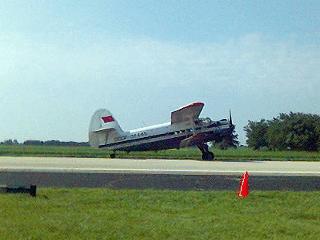
|
Here is a picture of another specialty aircraft. It is an Antonov AN-2 biplane. Each aircraft, old and new, is a very unique experience. The AN-2 allowed jumpers a slow exit airspeed on jumprun, roughly 50-60 Knots, at altitudes ranging from 4,500 to 7,000 feet. The AN-2 is an interesting classic biplane from just after World War I designated for cargo and early air travel in Russia. Huge radial engine, slow climb, low airspeed, and fuel / oil "old airplane" smell of the interior made for a unique jumping and ride-to-altitude experience, far different to the current days of turbine aircraft. Jumpers also received a free t-shirt after jumping the AN-2. |

|
Guess who is the tall man standing in the foreground at the manifest office at WFFC? It is Norman Kent, probably the best freefall cinematographer alive! This man has shot skydiving and air stunt sequences seen in many movies like "Drop Zone", commercials containing skydiving like "Pepsi", among many others. If you have seen skydiving in the movies, on TV, or ecen IMAX ... Most likely it was shot by Norman Kent. At the WFFC, Norman Kent was nice enough to film you (for hire) in any skydive, using his expertise in freefall photograpy at your disposal. |
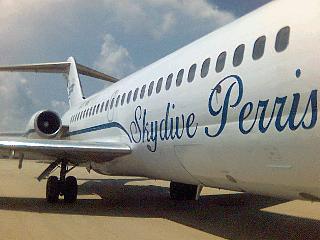
|
Here is the DC-9 Jet at the World Free Fall Convention. The plane belongs to Perris Valley Skydiving in California, and after many years of FAA red-tape (the plane, ofcourse, has to be APPROVED before it can drop jumpers) finally dropped jumpers at the WFFC in 2006. The last time a commercial airliner was jumped was a 727 back 1997 when thee WFFC was held in Quincy, Illinois. To get approval by the FAA, it took many steps including flight tests, as the rear door and "air-stairs" had to be removed, to make sure noise, safety, and aerodynamic parameters were not breached. The plane was first acquired by Perris back in 2002, and only dropped jumpers during WFFC in 2006 for a special-use waiver. For Perris drops, it will need to be approved again (which should be easier) than the initial FAA approval for WFFC 2006. |
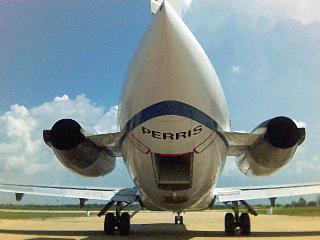
|
Here is a picture of the rear exit for the DC-9 jet. As you can see, the rear exit is open, and the "air-stairs" removed. You are basically jumping straight out the rear exit, fall through the "tunnel-like" opening, and into the 150-200 Knot free air stream under the belly of the airliner. Jumping this bird is like no other experience imaginable. Climb to 15,000 feet jump altitude takes a mere 4-minutes, exit is just a run and go - no separation at all, after exiting, a 200-MPH slipstream greets you with enough power to rip clothes, take your shoes off, and even break your eye goggles. You BETTER check those handles - and re-check em'! |
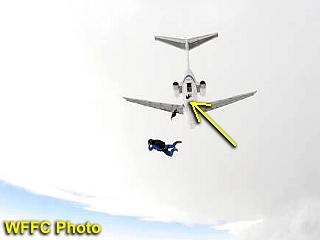
|
Here you go, a picture taken by one of the photographers (most likely Norman Kent) on my load on the DC-9 jet jump on July 29, 2006 at WFFC 15,000 feet over Rantoul, Illinois. In this picture, I am the jumper who just exited (the yellow arrow). The throw of this aircraft, due to it's high speed, causes jumpers to be hurled up to 2 miles during the first 45 seconds of their free fall. I am also experiencing a wind blast of about 150 knots (about 175 MPH) indicated (or a true airspeed of nearly 225 MPH). Note the interesting thunderstorm environment, with a large cirrus anvil in the background. This storm, which part of which some of us fell through, was to wreck more havoc at WFFC 2006 a few minutes after the jet load landed. |
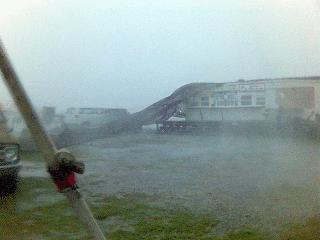
|
This is a picture of one of a few storm-related events that plagued the WFFC of 2006. The first round of storms occurred during mid week of July 22 to July 29, another on Saturday, July 29 (this one). Winds from severe thunderstorms, just after finishing the DC-9 jump, again slam into the WFFC. In this picture, torrential rains and winds tear down the camouflage canopy at the manifest office. Between the two storm events, damage was as much as $175,000 dollars. But this did nothing to stop the fun and jumping. |
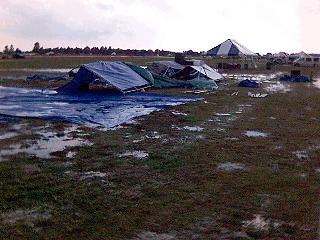
|
Damage to tents after severe thunderstorms blew through for the second time in a week at the 2006 WFFC. Damaged or not, jumping resumed once the skies cleared. |
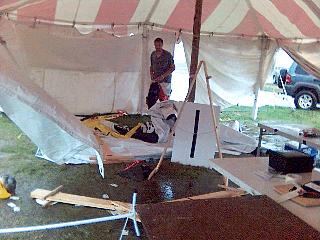
|
Some tents did not blow down but had much stuff inside them either blown out of the tent or scattered around. This one was the Skyfest (part of Skydive Dallas) tent, and much articles were either water damaged or broken by the severe thunderstorms. |
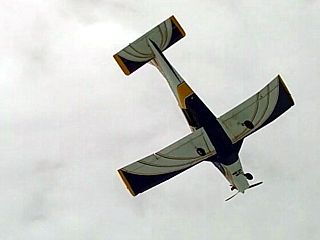
|
Here is a picture (taken from video) looking up at the jump aircraft, a PAC-750 XL, after exiting at 13,500 feet over Clewiston, Florida. I am opening immediately after exiting, at relatively high altitude, and holding the camera in my left hand! |

|
This is called a "Hop-N-Pop" (opening parachute right after exiting the aircraft). In this picture, the parachute inflates in the cold, thin air of the mid-troposphere. Note the cirrocumulus cloud deck in the background. |
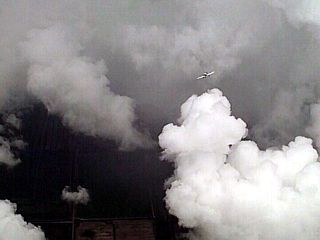
|
Here is a picture of the jump aircraft diving in front-of (and hopefully avoiding) a develping severe thunderstorm complex while viewed from nearly 13,500 feet over Clewiston, FL. |

|
Impressive towering cumulus clouds - While under parachute at roughly 9,000 feet over Labelle, Florida (roughly 3 miles NW of Clewiston). These clouds were part of a rapidly developing cluster of strong and severe thunderstorms (common during the summer months). Ofcourse, I am avoiding flying into such clouds. Not only is it illegal (see FAR 105), but with the horror stories of people being "sucked up" into thunderstorm updrafts, I am steering clear of the intense updrafts. |
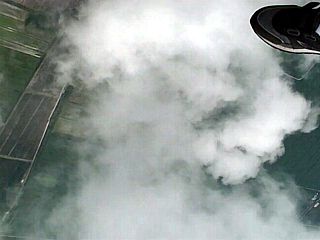
|
Looking down, my feet is still high above the clouds! I was on load #5, load #6 was cancelled due to "weather". Avoiding the developing storms, I made it back safely to the drop zone, with "this" to ponder ;-) |
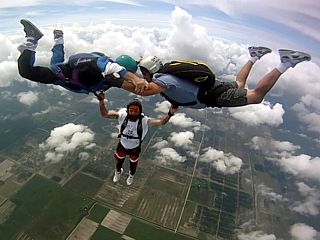
|
This is a picture from a video taken by a follow cameraman using a GoPro HD camera of myself and two others doing a 3-way "hybrid" skydive over Clewiston, FL in September of 2011. I am to the left, and another guy, Stuart is in front of me. The third guy hanging feet-first from iis is Rob and helt it for at least 3 seconds! |
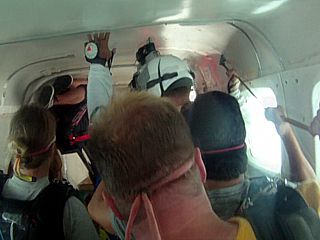
|
Here is a picture of the inside of a Cessna Caravan leveling out at the 13,500 foot exit altitude over Clewiston, Florida in May of 2011. The cool thing here is that the plane is executing a zero-G "pushover" maneuver, where a few seconds of weightlessness is experienced - Note the guy in the back (to the upper-left in the black jumpsuit), he has floated to the ceiling of the plane! |
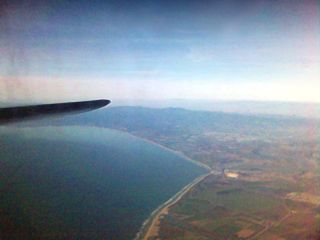
|
Here is a picture, poor quality as it was taken with a cell-phone camera, out the lexan sliding door of a Beechcraft King Air passing through 16,000 feet over Skydive Monteray Bay in California. The King Air is one of a few skydive planes that can climb to standard jump altitude in under 6 minutes (those few had its twin engines upgraded to PT6-34 at 750 shaft-horsepower each). The view here is looking north-northeast, and the curving coastline of the Pacific ocean stretches from Santa Cruz to Monterey. San Francisco, nearly 70 miles to the north, is just above the tail plane to the far left, with the entire San Jose "valley" and the highly-populated "Silicon Valley" area stretching to the right between two ridges (on in the foreground, and one distant in the background). Exit altitude varies between 16,000 and 18,000 feet in the fast-climbing King Air (on this jump it was 16,500 feet), making for a view worth its weight in gold. |
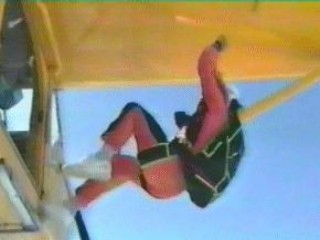
|
Doing a backwards skydive exit at 14,000 feet over Clewiston, Florida from a Turbine Porter aircraft. I did about four backloops on this exit. |
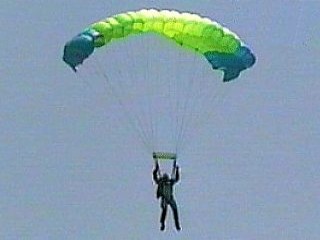
|
My photograph is taken by an observer while landing under canopy at Skydive Palm Beach. I am about 20 feet above the ground preparing for a near perfect landing after skydiving from about 14,000 feet. |
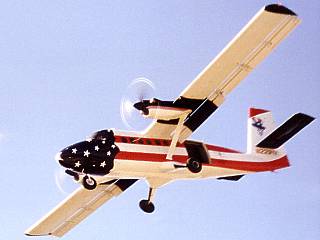
|
This picture was taken from the Skydive America drop zone at Pahokee Florida just as the Super Twin Otter "Mr Yankee Doodle" was making a landing after dropping a load of skydivers from high altitude. The plane holds up to 25 jumpers and had its original PT6A-20 turbines replaced with PT6A-34's. What does this mean? Takeoff to 13,500 feet in only 9 minutes instead of 20, getting twice as loads in the air per hour, and being able to climb higher and faster for those high altitude "specialty" jumps. Check out the "patriotic USA" paint scheme. |

|
This is a picture of an optical phenomenon called a "Pilot's Glory". It is a halo effect that occurs around shadows of aircraft on an underlying cloud deck. This picture was taken while I was skydiving, under canopy descent after jumping from 14,500 feet and opening my parachute at 7,500 feet AGL. I was about 500 feet above a stratocumulus cloud deck passing through 6,000 feet AGL where a shadow was cast on the cloud top with the glory (halo effect) around the shadow. Note the silhouette of my ram-air canopy with myself under it in the shadow. Cloud droplets in the cloud deck refract the sunlight back at different angles causing the colors in the halo. The reason why this effect occurs around the shadow is because the way light bends around the path of the shadow and the droplets / ice crystals in the cloud reflecting the light. The Pilot's Glory is a common sight by aviators flying over clouds in bright sunlight. |
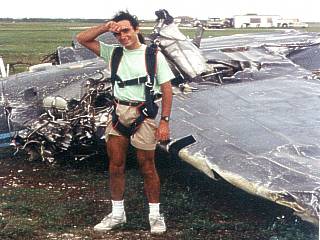
|
After skydiving in Homestead, Florida in November 1993, I pose in front of a destroyed airplane with a comical expression of me wiping sweat off my forehead. I am standing in a tandem skydiving harness walking back to manifest from the drop zone when I decide to have my picture taken in front of the plane wreckage, which was not from a plane crash, but hurricane Andrew which roared through the area a year earlier. |
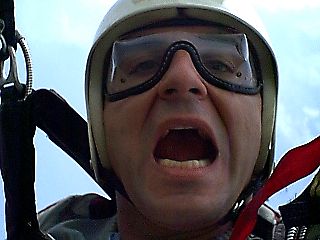
|
Using a digital camera, the effects of high g forces during a canopy spin become evident during a parachute descent over Pahokee, Florida. Pulling one toggle or handle on these type of ram air canopies, with the other toggle stowed, results in a strong spiraling descent in the direction of the applied toggle. Speeds under canopy once again can reach over 60 MPH with g loads over 4 G's. |
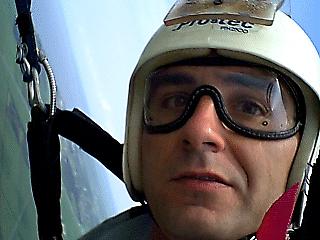
|
Taken using a digital camera, I photograph myself while under parachute descent over Pahokee, Florida. I am commensing a steep turn to the right, which puts me nearly horizontal to the ground. Note the riser from the harness in the left side of the picture, which is suspending me from the ram air type parachute versus the orientation of the horizon behind me. |
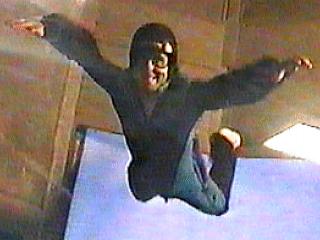
|
Indoors skydiving at the Skyventure wind tunnel in Orlando, Florida. This is a vertical wind tunnel where 5 giant fans draw air from the top of the unit and air flows in through a plenum at the base of the tunnel. In the test chamber, the air flows through a screen and narrow region creating a powerful updraft, up to 125 MPH. A window next to the test chamber allows observers to view and photograph the jumpers like myself in this picture. |
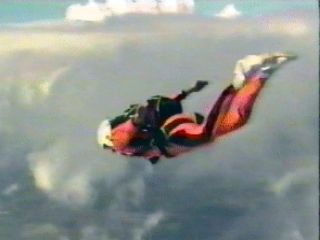
|
During a skydive from 13,000 feet over Clewiston, Florida, I track away from the cameraman filming by jump. Bringing your arms in to the side and pointing your legs can add up to 90 MPH of horizontal momentum to the existing 120 MPH of vertical momentum in a skydive! |
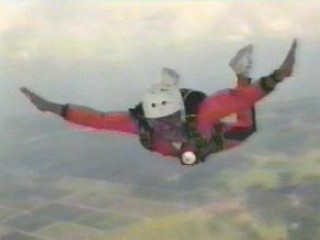
|
While skydiving from 13,500 feet over Clewiston, Florida, I wave off and face the cameraman prior to pulling my rip cord at about 3,500 feet. I am falling at least 120 MPH when freefall photographer and jump master Carl Smith video taped my sky dive with a helmet mounted camera. |
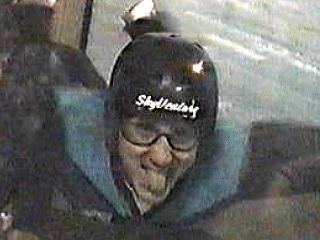
|
Smiling, or more likely, making a funny face for the camera of an observer filming me in a skydiving wind tunnel in Orlando, Florida. A large window off the wind tunnel test chamber allows observers to watch from the outside. |
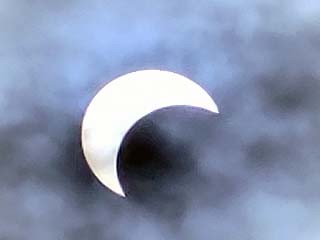
|
October 14, 2023 had an annular solar eclipse over the central USA. In Florida, and at the skydive place there in Clewiston, about 55 to 60 percent of the sun was covered as they got a partial eclipse there. In this picture, the sun is more than half blocked by the moon around 1 to 1:30 PM local time. |
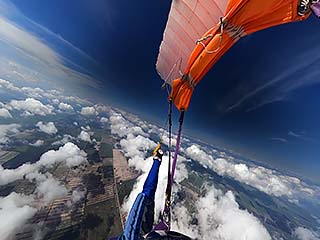
|
During a skydive, the atmosphere is noticibly dimmer, especially looking towards the west, as I open at 8,000 feet AGL to enjoy the view. |
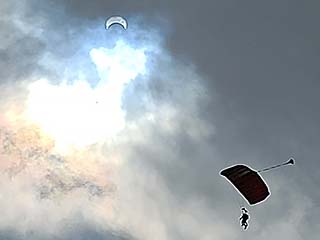
|
Skydivers landing under canopy with the partial eclipse above them. |
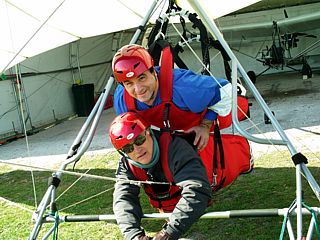
|
Here I am - On the top of my instructor pilot Marco, at "The Florida Ranch" airsports park west of Clewiston, FL and ready to take off and experience the thrill and exhileration of hang gliding! This hang glider is a TANDEM "ship" designed to introduce new students learning to fly into this exciting sport. It is to be towed via ultralight aircraft to an altitude of about 5,300 feet AGL (1 mile up) and released. |
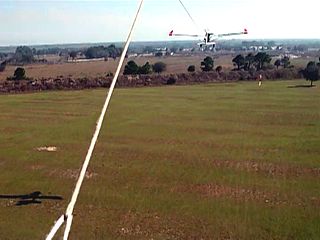
|
Here is a picture of us just after take-off in aero-tow en-route to 5,300 feet. An ultralight aircraft is the tow aircraft. |
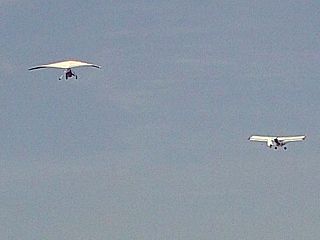
|
This is a picture of what it looks like to see the hang glider (left) and tow-plane (ultralight, to the right) just after take-off from a ground vantage point. |
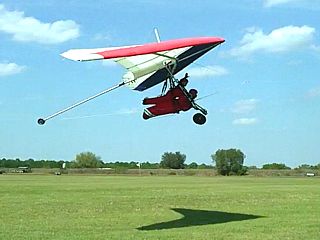
|
Here is another view of the tandem hang-glider just after take-off in aero-tow. |

|
This is a self-portrait of myself during the climb phase of the aero-tow of the hang glider. |
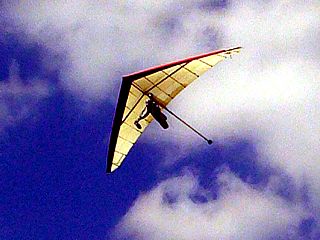
|
The experience of flying one of these hang gliders is second to none. Shifting your body weight is how you fly it. It's all about "attitude" and "center of weight". Shifting your body left and right turns the glider. Pushing your body back raises the nose. Moving forward lowers the nose. |
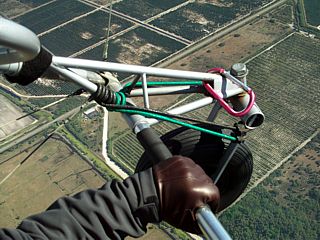
|
Pass on one of these rides / taking up this sport if you are afraid of heights. You truly are flying by the "seat of your pants' - literally! In this picture, we can see the hands of the instructor pilot on the control bar and a long-way down! |
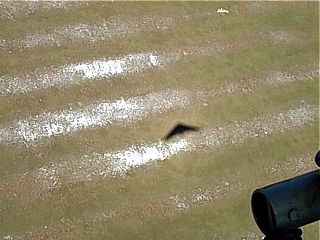
|
Here is a view of the last few turns and approach to land after the mile-high flight. A beautiful silhouette of our shadow appears on the grassy landing area as we set up for landing. |
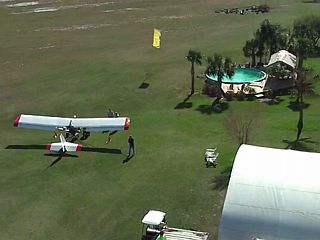
|
Here is another picture taken while on final and just before softly touching down. We pass over the hangars and tow-plane (ultralight) as we face the wind (see the flags?) for landing. |
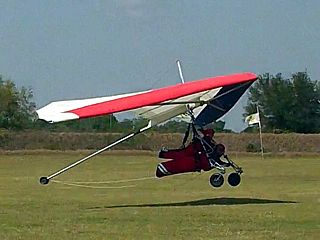
|
Touchdown! We safely land after being in the air for nearly a half hour (not bad for a mile up). These hang gliders, like stiff-wing gliders, also share the ability to find thermals (rising air) to stay aloft. |
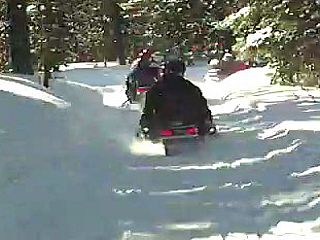
|
This is a picture from a snow mobiling trip I took with friends in the back-country trails of the Colorado Rockies near Breckenridge in February 2008. These are Polaris 550 trail-masters, and can reach speeds of over 55-MPH. |
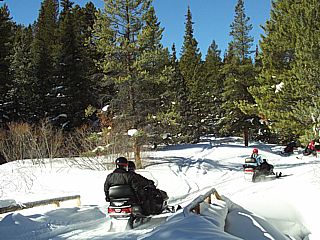
|
Here is another picture of the pristine landscape as we cross a small creek on a snow mobiling trip. This trip was provided by Good Times Adventures out of Breckenridge, Colorado, and included a guide who was able to take us through 25 miles of Colorado back-country trails. |
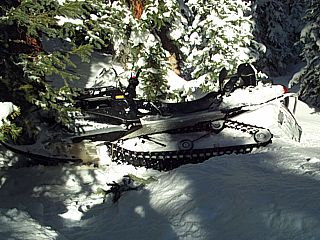
|
With any extreme sport, there is risk, and snow mobiling is no exception. In this picture, a snow mobile has ran off the trail, hit a tree, and lies broken in the snow. The rider, Tony Laubach (KC0ONL) jumped off before impact and handed in the snow nearby unhurt. Tony was not at fault of the accident. |
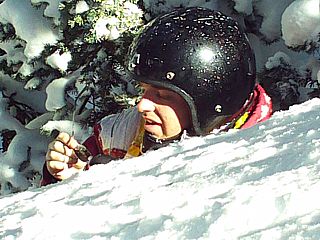
|
Here is a picture of Tony Laubach, unhurt, and buried in snow at least 10 feet deep. He is very lucky he did not get hurt, but had to pay for the repairs and damages to the sled, which totaled nearly $500. The snow here was so deep it took about 3 hours to haul the broken sled back onto the trail. |

|
After the storm of 1993, the waves are high at the beach near Reef Road in Palm Beach, Florida. I stop for a picture after a surfing session on a frigid day in March 1993. |

|
Here is a picture of me doing a little rock-climbing in - of all places - Kansas? You probably wondering where in Kansas you can go rock-climbing? There are actually quite a few places, as there are many small canyons and sandstone buttes, like the one you see me climbing in this picture, called "monument rocks". Close to the Colorado border, semi-arid western Kansas begins to take on a "Southwestern USA" look in some places. |
HTML File "skydive.htm" - Developed By Chris Collura
To Return To The HOME Page Of This Site Click The "INDEX.HTM" Link Here!